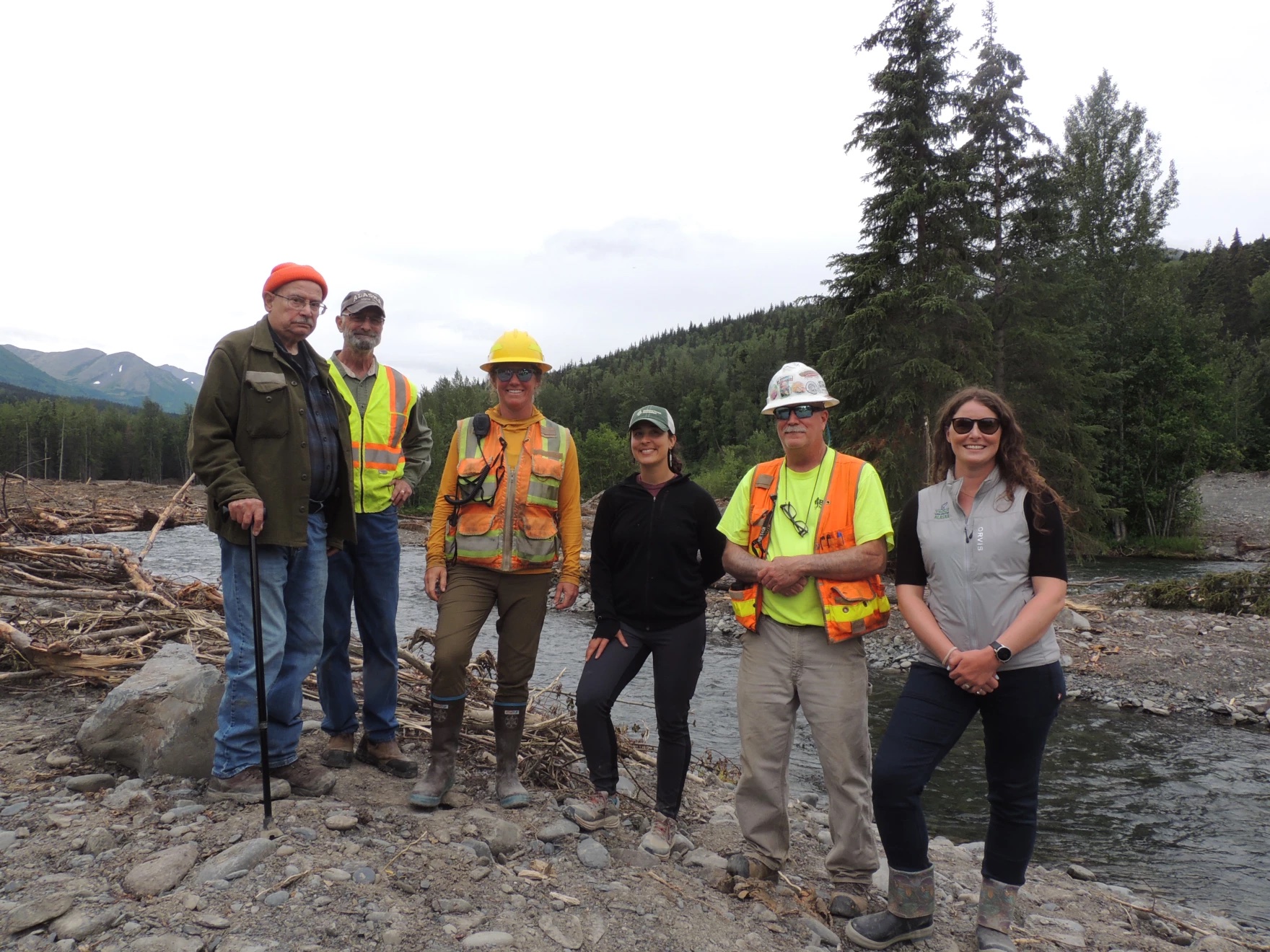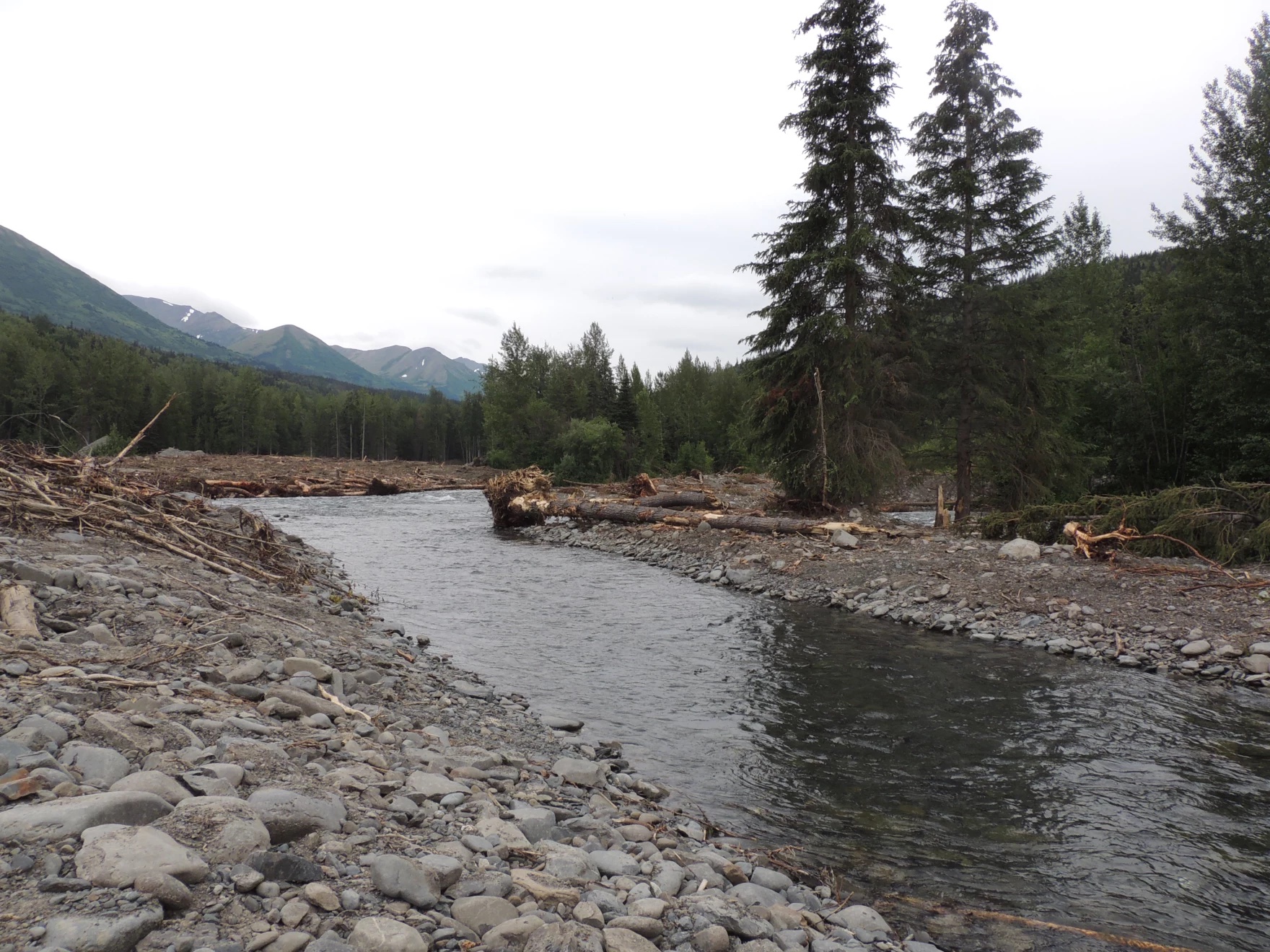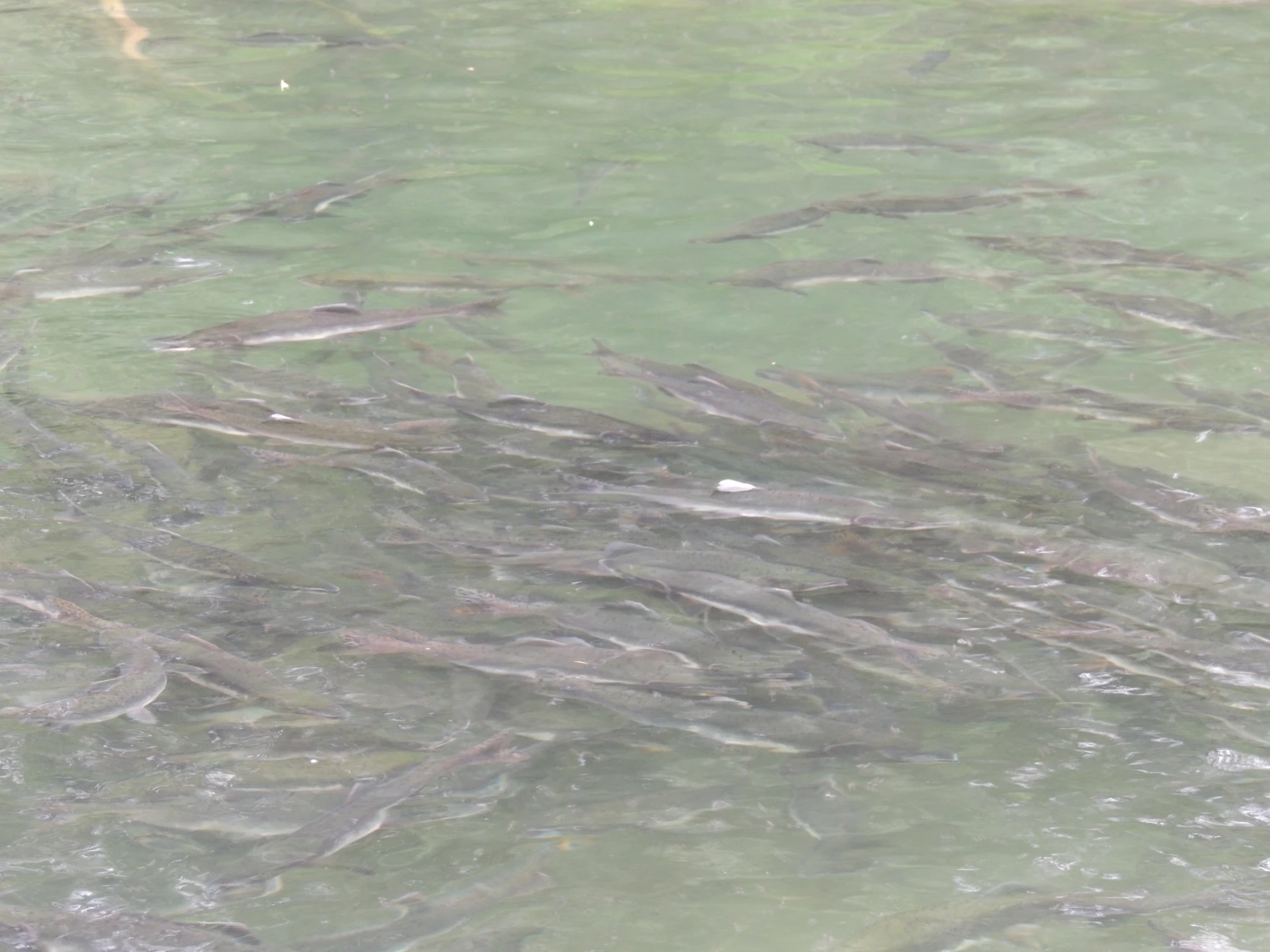Salmon Flourish After Mine Damage Restored In Alaska
7:15 minutes


This article is part of The State of Science, a series featuring science stories from public radio stations across the United States. This story, by Riley Board, was originally published by KDLL.
On Friday, July 28, there were hundreds of juvenile salmon clustered in a pool, in clear water surrounded by a bank of fresh woody debris. Not 100 yards away, a spinning drum processed sediment to extract gold.
This land is managed by a mining company, but it’s also the site of a major stream restoration project. Thousands of salmon are returning to this stream in Hope, more than 100 years after aggressive gold mining affected the path of the river. The project to restore Resurrection Creek has brought together a coalition of stakeholders, including the present-day mining company that occupies the site.
The restoration of Resurrection Creek began in the early 2000s. The goal was to correct habitat damage caused by historic mining.
More than 100 years ago, heavy mining activity in the gold rush town affected the stream pattern, turning it from a meandering creek to a straight ditch. Jim Roberts is vice president of Hope Mining Company, and he said hydraulic mining in the early 1900s fundamentally changed the waterway.
“So a very fast, deep river was great for mining. And the effect of that in this corridor, and the reason the Forest Service is here, is that it took this really nice, normally formed river with a lot of sinuosity and turned it into a rain gutter,” he said. “So that’s all great and fine for mining, but it’s really horrible for habitat.”
Two decades ago, the U.S. Forest Service took an interest in restoring the creek to a viable salmon watershed. Around 2005, people like project lead Brian Bair started work restoring a one-mile stretch of the river, outside of the mining company lands.
“The Chugach [National Forest] had identified an area where there was high fish productivity, so the fish were really happy with it,” Bair said. “So we went up, surveyed it, and then we used that as templates to design the lower area.”
Engineers used that template to redesign the stream’s path with bends, pools and slopes that made it ideal for salmon. After that restoration, the Forest Service reported a dramatic increase in salmon and other wildlife.
Then, the project moved on to phase two — restoring another two-mile leg that goes right through active mining claims. Collaboration between the mining company and Forest Service became critical in the progress of the project.

Hope Mining Company is a 2,200-acre mining leasing company, founded in the 1890s. The company pays royalties to the Bureau of Land Management and leases mining sites to individual gold miners. Owner Al Johnson bought the land on a whim, site unseen.
“At the time I was a business agent with the hotel and restaurant union,” Johnson said. “So I walk into one of my restaurants and the owner says, come in, would you like a coffee. So I walk in, sit down and she says, ‘Would you like to buy a gold mine?’ And I said, ‘What? What do I know from a gold mine?’”
The relationship between Hope Mining Company and the Forest Service was tense at first. Vice President Roberts said a turning point in that collaboration came when the two agreed on putting a bridge over the creek that could be used by both contractors and the miners.
“That allows us access to the other side of the river, which was very difficult before. It required driving through the river, which obviously isn’t great for river habitat and fish, and made it patently inaccessible most of the year,” Roberts said.
Now, after almost 20 years of fundraising and planning, the second phase is underway.
Corinne Marzoullo has been the engineer on the project. She said the creek has been redesigned to provide what salmon need to thrive — resting pools and hiding spots as they journey upriver.
“We’ve designed the meander bends to incorporate different channel features like riffles, pools and glides, because the river was just one straight riffle,” she said. The pools provide restings spots, the pools provide spawning locations.”
Marzoullo says different features are designed to cater to different salmon species, all of which inhabit this river.
“We’ve also incorporated woody debris and our large wood structures into the channel, so that provides bank stabilization, but also provides coverage from the bears that are cruising on through here,” she said.
Brian Bair said there was a sixfold impact on salmon populations, affecting all five species after phase one. So far, there have been thousands of fish in the stream following parts of phase two. Long-term monitoring will be necessary to see the eventual, total impacts on salmon numbers here.

Current mining activities along the restored corridor will have to wrap up in August. After the restoration is complete, mining will be allowed, but must meet high standards that involve returning the creek to its post-restoration state, and working closely with regulatory agencies.
The National Forest Foundation, the nonprofit partner of the Forest Service, helped leverage millions in funding for the project, from groups like NOAA and ConocoPhillips. The foundation raised $7.5 million for the project, which went toward the engineering and contracting work and will fund revegetation in the coming years.
Money for the project also comes from Trout Unlimited. Marian Giannulis is a spokesperson for the national fish conservation nonprofit. She said the group was hesitant to contribute to the project at first because of the active mining in the area.
“We didn’t get actively involved until we had assurance that this restoration corridor would not be mined again,” she said. “We had some reservations, we didn’t want to make the investments necessary to get a project of this scale off the ground until we knew that the work that would happen here would have lasting benefits to the local ecosystems in perpetuity.”
Trout Unlimited signed on after receiving a large private donation from Kinross Alaska, a gold mining company that Giannulis said shared an interest in restoring abandoned mining sites.
On Friday, there are so many salmon in the stream they splash out of the water trying to get around each other. But it isn’t just about the salmon. Giannulis said the whole ecosystem is affected, including moose and plant life. Just yesterday, she said, a young bear went fishing in one of those new pools.
Invest in quality science journalism by making a donation to Science Friday.
Riley Board is a Report for America Fellow at KDLL in Kenai, Alaska.
FLORA LICHTMAN: And now we’re going to talk about what one area of Alaska is doing to heal its habitat from mining. We’re paddling to a stretch of river called Resurrection Creek on Alaska’s Kenai Peninsula near Anchorage. More than a hundred years ago, miners started digging for gold there. Giant machines turned the sinuous river into a deep, straight ditch, and the salmon population plunged.
But Resurrection Creek is earning its name. Over the last few decades, there’s been an effort to restore the habitat for fish. And despite mining still happening in the area, the effort seems to be working. Joining me to talk about this project is my guest, Riley Board, Report for America fellow at KDLL in Kenai, Alaska. Welcome to Science Friday.
RILEY BOARD: Thanks so much for having me.
FLORA LICHTMAN: So what did mining do to the habitat and the salmon that lived there?
RILEY BOARD: Sure. So I think first I’ll turn to Jim Roberts to explain that. He’s the Vice President of the modern-day mining company that’s still based in this area, and he’s got a pretty good explainer on that.
JIM ROBERTS: So a very fast, deep river was great for mining. And the effect of that, in this corridor, and the reason the Forest Service is here, is it took this nice, normally formed river with a lot of sinuosity and turned it into a rain gutter.
RILEY BOARD: In order for salmon to thrive in a river habitat, they need places to stop and rest on their journey up river. And when mining turned this into a really straight, fast river, it made it really difficult for salmon to travel upstream and made it an unviable habitat for those fish.
FLORA LICHTMAN: Hmm? OK. So what are people doing to bring the creek back to what it used to be like? What are the actual interventions?
RILEY BOARD: Sure. So engineers have been working there on two different phases of the project, one that happened earlier in the 2000s and one that’s happening right now, and those phases are working to re-add those curves to the river that make it a great place for salmon to live. So they add two important things. One of them is pools for resting.
So salmon, as they’re swimming upstream, they need places to stop and rest so they’re not expending all of their energy, so they’re adding back in these pools where salmon can rest. And then, they’re also adding bends back in the river. And from what I understand, those bends are important for protecting salmon from their predators, like bears. As they travel up the river, they need places to hide from predators, and so that’s what those bends are for.
But also, there’s a lot of other features that involve complex engineering. And all five species of Pacific salmon live in this creek, and they all need different things, and so the engineers took all of those different species into account when they designed new features to add back into this river to make it a good habitat.
FLORA LICHTMAN: Hmm? Resting pools? I feel like this is what I need on even the shortest of runs.
RILEY BOARD: Yeah, absolutely.
FLORA LICHTMAN: So is the restoration working?
RILEY BOARD: Well, from what I understand, that first phase saw a six-fold return of salmon to the creek. You know, for a hundred years, there were very few salmon in this creek as a result of the straightening of the ditch. So that first phase brought back a six-fold return, and the current phase that the engineers are working on, it’ll take time. They’ll need time to study and see what the effects are.
But the engineers that I talked to seem very enthusiastic. They saw salmon returning faster than they even expected. And when I was there, at the end of July, I saw just pools of salmon, like piles of salmon.
FLORA LICHTMAN: Really?
RILEY BOARD: Yeah. You couldn’t even see the bottom of the creek through the absolute thicket of salmon. So on pure eyewitness account, there’s definitely been a return of fish to that creek.
FLORA LICHTMAN: This is Science Friday from WNYC Studios. You reported that a mining company that still operates in this stretch of river is actually involved in the restoration. What’s in it for them?
RILEY BOARD: Yeah. So from what I understand from talking to folks at that mining company and folks with the Forest Service, that relationship started off hostile when they first wanted to do a restoration project here because there are active mining claims through this corridor of the river. But, eventually, everyone came to the table.
They started negotiating. Realized that they weren’t, I believe, I’m quoting here, “warring nations,” and came to a mutual agreement. And a sort of turning point happened in their relationship when the Forest Service decided that it needed to build a bridge over the creek. For them, the purpose of that bridge was so that contractors could traverse the river when they were doing their restoration work.
But that bridge was also helpful for the mining company because previously they were just driving through the river to get from side to side, and so the Forest Service said, you can use this bridge too. This will work for miners. And so they came to this infrastructure compromise, and I think the relationship just improved from there.
FLORA LICHTMAN: A bridge? That’s what was in it for them?
RILEY BOARD: Yeah, literally.
FLORA LICHTMAN: Is mining still happening in this area, like on this stretch of the creek?
RILEY BOARD: Yeah. So when I visited earlier this summer, mining was still happening, although it was sort of wrapping up with the season. But, in the future, once this restoration project is complete, mining will be allowed to continue, but miners will have to meet extremely high standards when it comes to doing their work and then returning the area to its previous status.
FLORA LICHTMAN: If mining is going to continue on this river, what does it actually look like? Are they digging the river into a rain gutter again and then bringing it back? Or what’s the deal?
RILEY BOARD: Yeah. So mining today is much more sophisticated, and the equipment is really different from what happened there a hundred years ago. And so the miners are basically using the stream to clean their material and sort their material to find gold among the sediment. This isn’t exactly like an open pit mine where they’re displacing a ton of earth, so they’ll just be using the running water from the stream to clean the material and then resetting that area to the standards of the Forest Service.
FLORA LICHTMAN: Got it. How is this restoration affecting other wildlife, or what’s the hope?
RILEY BOARD: Yeah. So animals that eat salmon, like bears, obviously benefit from the return of salmon to this creek. And actually, when I got to visit in late July, everyone was raving about seeing a juvenile bear that had come to the creek to fish just the day before, which, as far as I know, wasn’t happening before.
And then, also part of this project is the revegetation of this stream corridor. That’s what’ll happen after the engineering of the creek is complete. They’re revegetating it to look like it’s pre-mining conditions, which will bring back, obviously, the vegetation but also things like moose and other animals that thrive in that environment.
FLORA LICHTMAN: That’s all the time we have for now. I’d like to thank my guest, Riley Board, Report for America fellow at KDLL in Kenai, Alaska. Thanks for joining us.
RILEY BOARD: Of course. Thanks for having me.
Copyright © 2023 Science Friday Initiative. All rights reserved. Science Friday transcripts are produced on a tight deadline by 3Play Media. Fidelity to the original aired/published audio or video file might vary, and text might be updated or amended in the future. For the authoritative record of Science Friday’s programming, please visit the original aired/published recording. For terms of use and more information, visit our policies pages at http://www.sciencefriday.com/about/policies/
Kathleen Davis is a producer and fill-in host at Science Friday, which means she spends her weeks researching, writing, editing, and sometimes talking into a microphone. She’s always eager to talk about freshwater lakes and Coney Island diners.
Flora Lichtman was the host of the podcast Every Little Thing. She’s a former Science Friday multimedia producer.